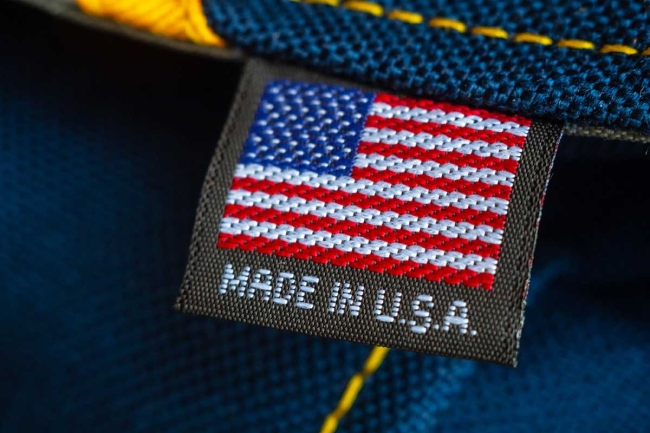Devin Steele is founder and publisher of U.S.-based eTextileCommunications.com, The Voice of the U.S. Textile industry, which covers the entire value chain of the textile, apparel and sewn products industry. A graduate of N.C. with a degree in English, he has covered the textile industry for more than 25 years and keeps one hand on the keyboard and the other on the pulse of this vibrant, amazing manufacturing sector.
Topics
How Technology Enables Made in America and Nearshore Production

During the COVID-19 pandemic, when the world turned virtual in many respects, everything seemed to change . . . or at least accelerate. This is certainly true from a technological standpoint, where change was fast-tracked to address the needs of a new operating environment for many businesses and individuals. At the same time, lingering issues that had not been properly addressed moved to the forefront, and companies began to take a closer look at ways to turn many of them into opportunities.
This is especially true of the textile and apparel industry and their brand and retail partners, as noted by several speakers during the recent Americas Apparel Producers’ Network’s (AAPN’s) Annual Conference, which attracted nearly 200 attendees (virtually, of course) from the Western Hemisphere. Sustainability, fast fashion, personalization, customization, digitization, nearshoring, consumer shopping behaviors and supply chains are always top of mind to this sector, and how the industry is working to implement the technological tools necessary to capitalize on these opportunities and trends was an underlying theme of the event.
In many instances, the industry came together to collaborate and figure out ways to alleviate the critical shortage of personal protective equipment (PPE) during early weeks and months of the pandemic. And lessons learned from that disruptive experience may serve as a model for cooperation to nearshore production and help avoid such problems going forward.
Sourcing and Strategy
Putting together the pieces of a hemispheric strategy—the primary goal of the AAPN being to connect the players of the Americas—was the order of the day. In that regard, a former managing director of the World Bank Group and current president of a business investment council for Northern Triangle countries and the U.S., explained his group’s goal of achieving a win-win for all by creating job opportunities that would effectively reduce the United States’ dependence on mostly Asia-made goods and reduce the crisis on the U.S. southern border. He laid out a roadmap that potentially could create 2 million jobs in the four countries.
The council is looking to create various clusters that could underpin and improve areas, such as transportation infrastructure, telecommunications, energy, logistics and innovation. One of those, a “textile cluster,” has huge potential, he said.
Technology to Transform
“Nearshoring and new technologies such as automation are enablers that can help us reduce CO2 emissions and achieve a circular value chain, all the way from a zero-waste design process to production of renewable and sustainable fibers,” he said. “Nearshored fabric industries could invest in resource-efficient, sustainable technologies with automated finishing, significantly reducing the use of energy, water and chemicals.”
He added that automated production of high-quality, customized garments would increase the value of fast-fashion items for consumers and prolong garment life. Also, on-demand production and distribution and an improved recycling business has great potential to minimize waste by reducing unsold items and inventory, further reducing shipping costs and emissions, he pointed out.
Fast fashion and more customized and unique garments are in demand with consumers. The right Shop Floor Control (SFC) factory management solution offers the real-time data and insights needed to tighten processes and produce shorter, more rapid runs. Executives, managers and individual producers can use SFC to ramp up production, reduce errors, meet more goals and pivot more rapidly.
Coupled with SFC, a no-code, scalable product lifecycle management (PLM) tool can accelerate collaboration and help shorten design and times to production and market. By bringing everyone, from fashion designers to the factory floor, closer to the consumer, brands can get feedback and respond more quickly to changing trends.
Made in America
Another speaker, an executive from a major U.S.-based retailer, spoke of the global company’s made-in-America initiative and how a resilient supply chain in the Western Hemisphere is important to that mission. And producing closer to home helps increase transparency in the area of sustainability, which continues to rise in importance to consumers and remains a priority for the company as it relates to its suppliers and customer demands, she said.
“We know we can reduce emissions, but our sustainability commitment doesn’t just stop there,” she said. “There are other areas we can have an impact on, especially through making textiles and apparel here in the U.S. and in this hemisphere. We can also impact waste and improve circularity. We’re excited to see some of the broader impacts we can have as we think about recycled fibers, yarns and fabrics.”
She added that not only does being sustainable provide opportunities for cost reduction and growth, but being a green-focused, low-impact company with suppliers with good stewardship is also “the right thing to do.”
Social and Omnichannel
Later, the head of the American Apparel & Footwear Association (AAFA), whose members produce or source far and wide, said he is hearing increasing rumblings from retailer and brand constituents seeking to build more supply chains closer to home – and the pandemic likely has hastened that thinking, he added. He noted that while brick and mortar took a big hit, eCommerce “exploded” over the past 14 months.
“And it will continue to grow, but it will do so in a much more integrated way with retail,” he said. “We’ve heard the word ‘omnichannel’ for years, and that will come into play in an even bigger way. We are still social creatures. We like to see each other, so we will begin to get out more, but virtual technologies aren’t going anywhere.”
Closer to Home
Rounding out nearly a full day of presentations covering these issues and how technology is driving much of the change as we emerge from the pandemic, the president of Honduras-based textile company Elcatex, which supplies product to numerous brands and retailers, said the days of generally sourcing from China at the lowest price are nearly over.
“The trend of nearshoring, the exponential growth of eCommerce, the internal demand within Asia, especially China, the geopolitical issues that we’re experiencing … all of those factors are really changing how this industry is going to develop in this hemisphere,” he said. “You need to produce closer to home, and we in CAFTA countries are the closest option to the United States. We’re committed to expand and invest in technologies to meet the growing demand that this region is going to have.”
The right technologies successfully implemented will be crucial in making changes and market shifts. In addition to SFC and PLM, the right enterprise resource planning (ERP) suite can give you the necessary visibility and transparency across your entire supply chain and operations. Using financial, inventory, business intelligence and other powerful tools, you can capture, parse and use data to make more informed decisions, faster.
Devin Steele is founder and publisher of U.S.-based eTextileCommunications.com, The Voice of the U.S. Textile industry, which covers the entire value chain of the textile, apparel and sewn products industry. A graduate of N.C. with a degree in English, he has covered the textile industry for more than 25 years and keeps one hand on the keyboard and the other on the pulse of this vibrant, amazing manufacturing sector.

